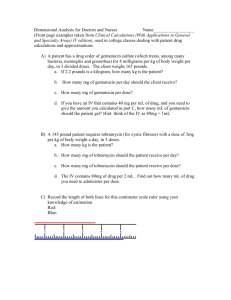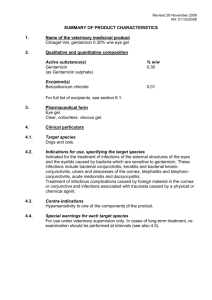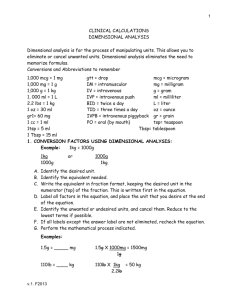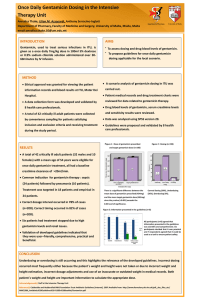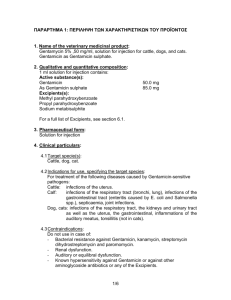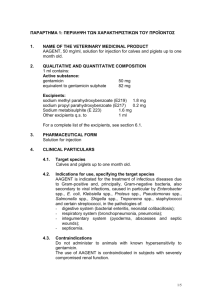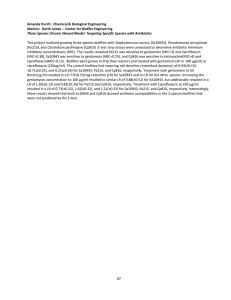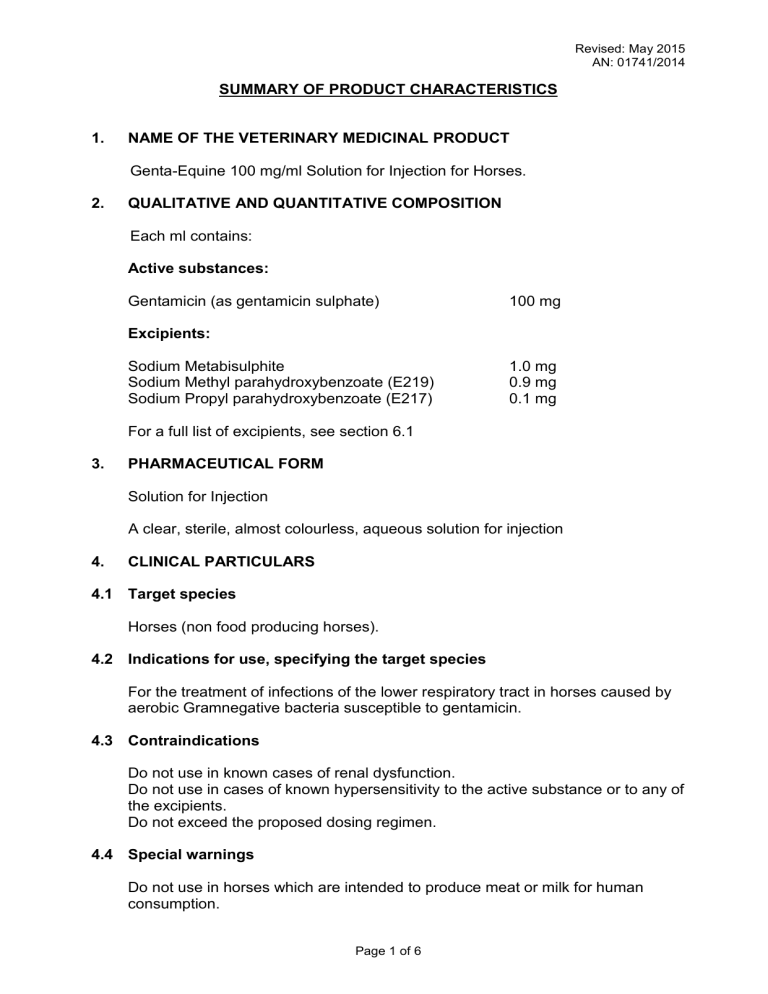
Revised: May 2015 AN: 01741/2014 SUMMARY OF PRODUCT CHARACTERISTICS 1. NAME OF THE VETERINARY MEDICINAL PRODUCT Genta-Equine 100 mg/ml Solution for Injection for Horses. 2. QUALITATIVE AND QUANTITATIVE COMPOSITION Each ml contains: Active substances: Gentamicin (as gentamicin sulphate) 100 mg Excipients: Sodium Metabisulphite Sodium Methyl parahydroxybenzoate (E219) Sodium Propyl parahydroxybenzoate (E217) 1.0 mg 0.9 mg 0.1 mg For a full list of excipients, see section 6.1 3. PHARMACEUTICAL FORM Solution for Injection A clear, sterile, almost colourless, aqueous solution for injection 4. CLINICAL PARTICULARS 4.1 Target species Horses (non food producing horses). 4.2 Indications for use, specifying the target species For the treatment of infections of the lower respiratory tract in horses caused by aerobic Gramnegative bacteria susceptible to gentamicin. 4.3 Contraindications Do not use in known cases of renal dysfunction. Do not use in cases of known hypersensitivity to the active substance or to any of the excipients. Do not exceed the proposed dosing regimen. 4.4 Special warnings Do not use in horses which are intended to produce meat or milk for human consumption. Page 1 of 6 Revised: May 2015 AN: 01741/2014 4.5 Special precautions for use Special precautions for use in animals Horses: Gentamicin is well known to induce nephrotoxicity even at therapeutic doses. There are also isolated reports of ototoxicity with gentamicin. No margin of safety has been established under the approved dosing regimen. As such, gentamicin has a narrow margin of safety. The product should therefore only be used based on the benefit-risk assessment by the responsible veterinary surgeon for each individual horse, taking into account alternative available treatment. In order to reduce the nephrotoxic risk, adequate hydration of animals under treatment should be ensured, and fluid therapy should be instituted, if required. Close monitoring of horses being treated with gentamicin is strongly advised. This monitoring includes assessing relevant kidney parameters in blood (e.g. creatinine and urea) and urinalysis (e.g. gamma glutamyl transferase/creatinine ratio). Therapeutic blood monitoring of gentamicin concentration is also recommended because of known individual animal variations in peak and trough gentamicin plasma concentrations. Where blood monitoring is available, target peak plasma gentamicin concentrations should be approximately 16–20 μg/ml. Particular caution should be taken when administering gentamicin with other potential nephrotoxic medicinal products (containing e.g. NSAIDs, furosemide, and other aminoglycosides). Safety of gentamicin has not been established in foals and there is a lack of knowledge of the extra effects of gentamicin on foal kidneys, especially neonates. Current knowledge suggests that foals, especially neonates, are at a higher risk of gentamicin-induced nephrotoxicity compared to adults. Differences between neonatal foal kidneys and adults include a slower clearance of gentamicin in foals. As such, no margin of safety has been established in neonatal foals. It is therefore not recommended to use the product in foals. Whenever possible, use of the product should be based on susceptibility testing of the bacteria isolated from the animal. Gentamicin is a narrow-spectrum Gramnegative bactericidal antimicrobial, without effects on anaerobe bacteria and mycoplasmas. Gentamicin does not penetrate intracellularly, or into abscesses. Gentamicin is de-activated in the presence of inflammatory debris, low oxygen environments and low pH. The dosing regimen must not be exceeded. Use of the product deviating from the instructions given in the SPC increases the risk of nephrotoxicity, and may increase the prevalence of bacteria resistant to gentamicin. Extra caution is advised if using gentamicin in old horses, or with fever, endotoxemia, sepsis and dehydration. Special precautions to be taken by the person administering the veterinary medicinal product to animals. People with known hypersensitivity to gentamicin should avoid contact with the veterinary medicinal product. Administer the veterinary medicinal product with caution. Page 2 of 6 Revised: May 2015 AN: 01741/2014 In case of accidental self-injection, seek medical advice immediately and show the package leaflet or the label to the physician. 4.6 Adverse reactions (frequency and seriousness) A local reaction may occur at the injection site, especially in case of repeated injections in adjacent sites. See Section 4.5i 4.7 Use during pregnancy, lactation or lay The safety in pregnant horses is unknown. However, studies in laboratory animals have shown evidence of fetal nephrotoxicity. Use only based on the benefit-risk assessment by the responsible veterinarian. 4.8 Interaction with other medicinal products and other forms of interaction This product should not be used in conjunction with other aminoglycoside antibiotics, or with other drugs known to induce either ototoxicity or nephrotoxicity. 4.9 Amounts to be administered and administration route Horses: Intravenous use. Single dose of 6.6 mg/kg body weight given intravenously once daily for 3–5 consecutive days. To ensure a correct dosage, bodyweight should be determined as accurately as possible to avoid under- or over-dosing. The dosing regimen must not be exceeded. The use of gentamicin in foals and neonates is not recommended. 4.10 Overdose (symptoms, emergency procedures, antidotes) The product was not specifically tested in overdose studies and therefore, no margin of safety has been determined. 4.11 Withdrawal period(s) Not authorised for use in horses producing meat or milk for human consumption. 5. PHARMACOLOGICAL PROPERTIES Pharmacotherapeutic group: Antibacterials for systemic use, gentamicin. ATCvet Code: QJ01GB03 5.1 Pharmacodynamic properties Gentamicin sulphate exerts concentration-dependent bacterial killing characteristics. Their rate of killing increases as the gentamicin concentration Page 3 of 6 Revised: May 2015 AN: 01741/2014 increases above the minimum concentration (MIC) for a given Gram-negative pathogen, with optimal maximum serum concentration (Cmax) to MIC ratio of 810. Gentamicin sulphate is bactericidal in action by irreversibly binding to 30S ribosomal subunits, and acts through two different mechanisms. In one mechanism, gentamicin can interfere with the correct amino acid polymerisation and elongation. This mechanism takes place at high concentrations. Another mechanism predominates at low concentrations in which amino acid codons are misread by tRNA and proof-reading is impaired. This leads to incorrect amino acid sequencing and nonsense proteins. The substance is highly polar, hydrophilic and transport appears to be an active process closely linked to electron transport, oxidative phosphorylation and the respiratory quinones in the cell membrane. Gentamicin is primarily distributed within extracellular fluids. Gentamicin does not distribute to the cerebrospinal fluid. Gentamicin is best considered as a narrow-spectrum Gram-negative bactericidal antimicrobial (e.g. E. coli, Proteus, Pseudomonas). Gentamicin does not have effects on anaerobe bacteria and mycoplasmas. Gentamicin does not penetrate intracellularly, or into abscesses. Gentamicin is deactivated in the presence of inflammatory debris, low oxygen environments and low pH. Gentamicin is eliminated unchanged by the kidney via glomerular filtration, including 85–95% of the dose. There are several mechanisms by which various strains of bacteria have developed resistance against aminoglycosides like gentamicin. Enzymatic modification is the most common type of aminoglycoside resistance. Over 50 different enzymes have been identified. Enzymatic modification results in highlevel resistance. The genes encoding for aminoglycoside modifying enzymes are usually found on plasmids and transposons. There are three types of aminoglycoside modifying enzymes: 1. N-Acetyltransferases (AAC) – catalyses acetyl CoA-dependent acetylation of an amino group 2. O-Adenyltransferases (ANT) – catalyses ATP-dependent adenylation of hydroxyl group 3. O-Phosphotransferases (APH) – catalyses ATP-dependent phosphorylation of a hydroxyl group Two other mechanisms of resistance include ribosomal mutations of the binding site of aminoglycosides, the 30S subunit, and the bacteria decreasing the permeability of aminoglycosides. 5.2 Pharmacokinetics Gentamicin sulphate is poorly absorbed from the gastrointestinal tract thus the product must be administered parenterally for systemic action. Gentamicin is rapidly absorbed from intramuscular injections: peak plasma concentrations being reached in ½ to 2 hours. It appears in the synovial and peritoneal fluids but effective levels are not reached in CSF, bronchial secretions, ocular fluids or milk. Elimination is mainly by glomerular filtration and it rapidly appears in the urine. Gentamicin is a highly polar drug with poor tissue penetration; it distributes mainly into extracellular fluids. Page 4 of 6 Revised: May 2015 AN: 01741/2014 6. PHARMACEUTICAL PARTICULARS 6.1 List of excipients Sodium methyl parahydroxybenzoate (E219) Sodium propyl parahydroxybenzoate (E217) Sodium Metabisulphite Sodium citrate Edetic acid Citric acid monohydrate Water for Injections 6.2 Incompatibilities None known 6.3 Shelf life Shelf-life of the veterinary medicinal product as packaged for sale: 2 years Shelf-life after first opening the immediate packaging: 28 days 6.4 Special precautions for storage Protect from light. 6.5 Nature and composition of immediate packaging 100 ml clear, Type II glass vial sealed with Type I bromobutyl bung and aluminium overseal. 6.6 Special precautions for the disposal of unused veterinary medicinal product or waste materials derived from the use of such products Any unused veterinary medicinal product or waste materials derived from such veterinary medicinal products should be disposed of in accordance with local requirements. 7. MARKETING AUTHORISATION HOLDER Franklin Pharmaceuticals Ltd Athboy Road Trim Co. Meath Ireland 8. MARKETING AUTHORISATION NUMBER Vm 33848/4000 9. DATE OF FIRST AUTHORISATION 07 July 2009 Page 5 of 6 Revised: May 2015 AN: 01741/2014 10. DATE OF REVISION OF THE TEXT May 2015 Approved: 08 July 2015 Page 6 of 6
